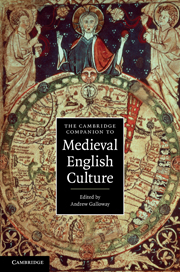Book contents
- Frontmatter
- Introduction
- Part one Theaters of culture: political, legal, material
- 1 From court to nation
- 2 The legal revolution and the discourse of dispute in the twelfth century
- 3 Archaeology and post-Conquest England
- Part two Cultural ideals and cultural conflicts
- Part Three Literacies, languages, and literatures
- Part four Legacies and re-creations
- Guides to further reading
- Index
3 - Archaeology and post-Conquest England
from Part one - Theaters of culture: political, legal, material
Published online by Cambridge University Press: 28 July 2011
- Frontmatter
- Introduction
- Part one Theaters of culture: political, legal, material
- 1 From court to nation
- 2 The legal revolution and the discourse of dispute in the twelfth century
- 3 Archaeology and post-Conquest England
- Part two Cultural ideals and cultural conflicts
- Part Three Literacies, languages, and literatures
- Part four Legacies and re-creations
- Guides to further reading
- Index
Summary
Archaeology is usually described as “the study of the human past through material remains,” and is dependent upon physical survival. For the Middle Ages, however, documentary evidence can also reveal how people interacted with their material culture: the environment and buildings in which they lived and moved and the things that they inherited, made, bought, stole, found or were given. “Inheritance” could be both family bequests and what survived from the past to help to shape the present: a medieval peasant, for instance, might unknowingly have worked within field banks that had been laid out in the Bronze Age. If he plowed over those banks to establish fields of a shape more suited to the new technology of open fields, or to create an assart for himself, his action would have been recorded only if subsequent disputes with his neighbors led to manorial court proceedings. Similarly, a Roman finger ring set with a gem might be found and returned to use, reinterpreted with Christian meaning, but would usually be documented only if it were subsequently stolen. Historians seek to go behind court records to consider what hedge destruction reveals about commoners' expressions of resistance, either to fellow peasants overreaching themselves or to overbearing landlords; or what thefts can reveal about the insecurity felt by their victims. In the same way, archaeologists are not content to observe a lynchet or a finger ring without passing on to question the meanings that they may have had for those who were constrained by or owned them, and how those meanings may have changed.
- Type
- Chapter
- Information
- The Cambridge Companion to Medieval English Culture , pp. 66 - 84Publisher: Cambridge University PressPrint publication year: 2011



